The second and last evening in El Salvador went more or less as I planned. I washed my hair, did my laundry, checked my emails and I also made sure I had beer and nachos which I enjoyed on “my” terrace. I went to bed early, since the beer made me sleepy, plus I knew I would be getting up very early. They woke me up at 3.50 am. By the way, there were no phones in this hotel, but rather the guests were given a very personal service by one of the employees coming to your room and knocking on the door until you said you had woken up.
Having reported that I had woken up, I did think that I could snooze a little, but I gave up since I thought it was not worth trying during some ten minutes I had available. So, I got up, got ready and went down, and since the coach terminal was right there, soon I got into the coach, put my earplugs, covered myself with the small fleece blanket and slept with some mini-breaks for some 3 hours more! With what I had slept during the night, this was supposed to be quite decently sufficient for this day.
However, since we were to reach Managua, the capital of Nicaragua, around 4-5 pm, I did nap some more from time to time. Namely, the distance between San Salvador and Managua is around 550 km and taking into account that two borders needed to be crossed, the entire journey took almost 12 hours.
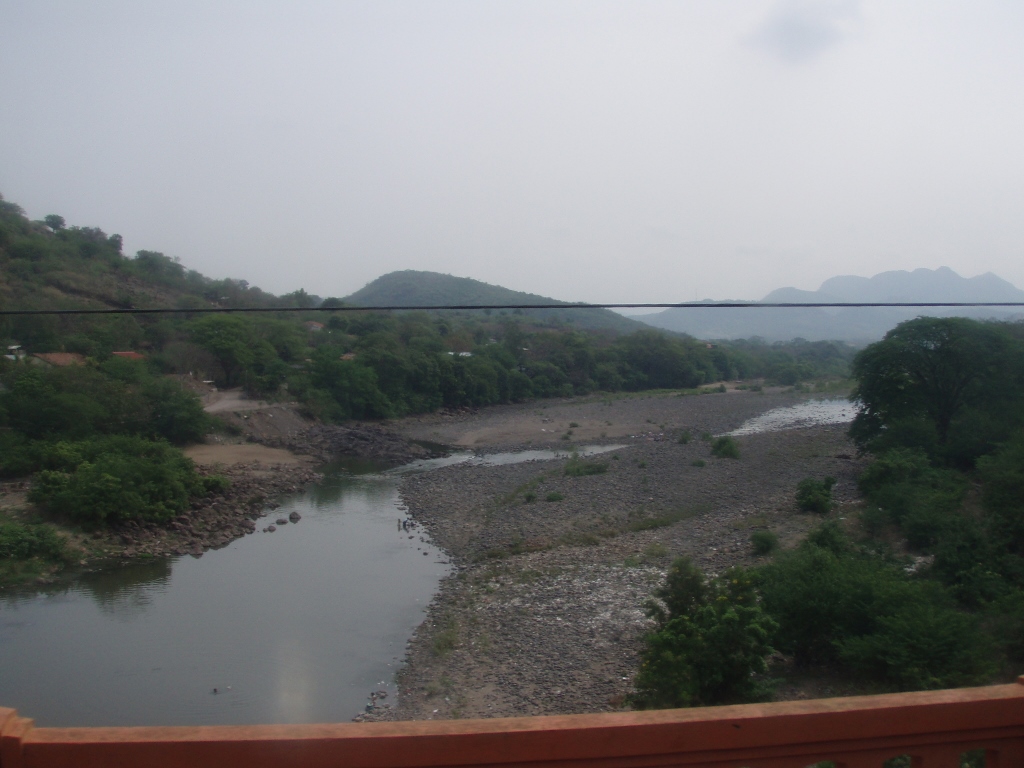 Somewhere between San Salvador and Managua
Somewhere between San Salvador and Managua
When I say two borders, I’m thinking of the fact that on its way between San Salvador and Managua, the coach had to go over the territory of Honduras. I postponed my visit to Honduras until later and now I was heading for Managua which was also my final destination in relation to the initial point – after Managua I basically started to return to Cancun (since my return flight back to Europe was leaving from there), but following a different route.
And since I’m mentioning El Salvador and Honduras, this is certainly a good moment to mention the perhaps weirdest war that has ever been fought. In fact, war is never a nice and funny thing, but it constitutes a reality of human existence and sometimes the reasons for a war may even be noble, for instance, when this concerns liberation wars. Also, in the case of all wars there are numerous clear, open and surface-level elements and motives, and those that are hidden, secret and deep. Both with regards to the beginning of the war and concerning its end. In addition, in the case of all wars there are always some deeper reasons and causes, while the occasions, almost excuses, for it can be very diverse.
Thus, it was precisely the occasion for this war I’m thinking of what makes it “weird” and even perhaps “interesting,” but certainly trivial enough and absolutely unique. The war I’m talking about is – the Football War! This war was fought in 1969 between El Salvador and Honduras. The causes were linked to migration and land reform, but in their essence to economic issues (somewhere deep in their basis, in the case of the majority of wars there is money, no matter what currency is in question), and the occasion...
In 1969 there were football matches played for the 1970 FIFA World Cup qualifications. In the second round of the group stage, El Salvador and Honduras were tied, so there was a play-off on a neutral terrain. El Salvador won, but... The fans had altercations already at the first game in Tegucigalpa and even more at the second game in San Salvador. Approximately at the time of the play-off, El Salvador dissolved all diplomatic ties with Honduras, stating that since the football game in San Salvador a large number of Salvadorans were forced to flee Honduras and then on 14 July 1969 the war started by El Salvador attacking Honduras. The ceasefire was negotiated soon, already on 18 July and for this reason the war is often referred to as the 100 Hour War. Then there was withdrawal of the army troops, the peace treaty was signed and there was also an international court process and the signing of the demarcation treaty. All of this lasted until 1998, although even today there are certain tensions between El Salvador and Honduras.
I was oblivious to all of this when in May 2008 I travelled from El Salvador, via Honduras, to Nicaragua. Moreover, everything was sufficiently peaceful that I only looked at the landscapes we were driving through, occasionally taking photos. It was precisely while I was passing through Nicaragua that I became aware that it could clearly be seen that May is the end of the dry season. The entire vegetation mostly appeared quite dried out, but then again I did see a tree that lived by the road in all of its huge size and impressiveness.
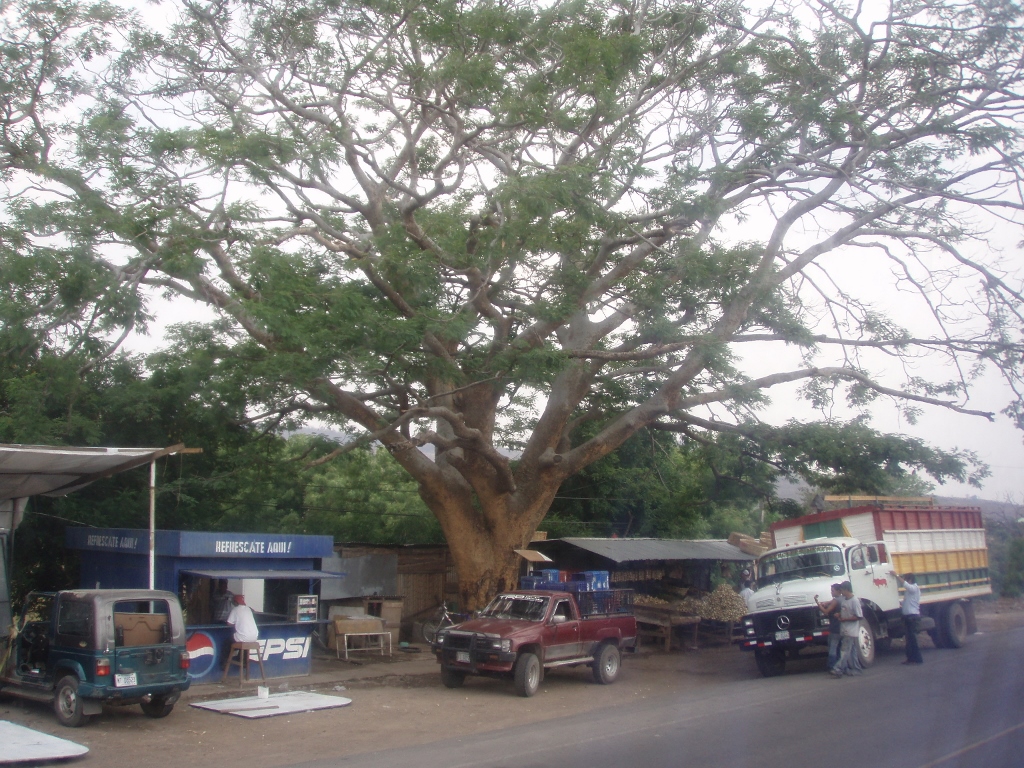 Getting close to Managua
Getting close to Managua
As it turned out, the duration of the journey was in fact only an estimate given by the transportation company in order for everybody to be prepared for a long haul. In reality, I got to Managua a little over an hour before the expected arrival time, so this was quite fine.
I had already decided to stay in a modest guest-house that had two important advantages: it had air-conditioning and it was located very close to the terminal of Ticabus that covers these international lines in Central America.
I needed the air-conditioning since until this point Managua was the hottest place on my journey. The city is situated at mere 80 metres above sea level, in addition to which it is surrounded by large bodies of water: the Pacific coast is some 60 km to the southwest and west, north of the city there is the second largest lake in the country, Managua Lake, while some 50 km to the southeast there is the shore of the biggest lake in the country, Nicaragua Lake, which is also the biggest lake in all of Central America.
What I want to say is that the heat, as well as the high air humidity felt very unpleasant and no help was coming from any higher altitude, so I thought I needed air-conditioning, particularly for the night.
As for the proximity of the coach terminal, it was good upon my arrival to have a room at less than 100 m from the terminal, but this was even more important for the continuation of my journey when the coach was leaving at 5 am again, while the passengers were required to be at the terminal already at 4 am. In other words, the closeness of my guest-house was of key importance here.
When I got to that guest-house, and that was practically a small complex consisting of ground-floor structures (the landlady’s house, auxiliary buildings and a few rooms for guests) surrounding a courtyard, I found two elderly gentlemen there who were friends of the landlady, but I had to wait a little until the landlady herself came. She offered to me to choose between two rooms that were accessed directly from the courtyard and when I did so, she disappeared again. So, I left my things in the room, got back to the courtyard and asked those men if they knew from where I could call Patricia (a little bit more about here in a short while). One of them lent me his mobile phone and in some ten seconds I agreed with Patricia that she would come to fetch me in an hour and a half.
My next “task” was to exchange money, so I asked the two men again and one of them offered to drive me to an exchange office. While we were starting, I saw from the car two Canadian guys with whom I came from San Salvador by the same coach and they were standing on a corner by the terminal, with their backpacks on, apparently trying to get their bearings. Taking into account that I had not only already gotten my room, but was also organising myself very well here, I was very, very content.
Naturally, along the way I chatted with this kind gentleman and it turned out that back in the day he had actually been in Belgrade, as a delegate of his country when the first Summit of the Non-Aligned Movement was organised in Serbia. I thought this was quite an interesting thing and I was talking to an almost historic figure.
When I exchanged money and returned to the guest-house, I had a quick shower, changed my clothes and then sat at a computer at the guest-house that had an internet connection, so I could check my emails and exchange messages with my friends and family.
Now let me explain who Patricia is. This was a young woman I found through internet or, to be more precise, through one of the numerous sites for free accommodation, food and company during travels. As I’ve mentioned earlier, by the rule I am not interested in free accommodation and food, but whenever I see fit I like to try to get in touch with some of the local residents, since that can be interesting. Thus I had already gotten in touch with a certain Patricia and she wrote back saying that she looked forward to meeting me and so she gave me her mobile phone number which I called upon my arrival. So, now I was waiting for her to show up at my guest-house and this happened soon enough.
Patricia came with her friend Marta and then we first went for coffee and a little later for light dinner as well. I should say that during my stay in Nicaragua I used my photo- and video- cameras quite sporadically and this was also the case on this occasion. That’s why I have only a photograph of the afternoon coffee, there is no photo of the dinner, but I do have a photo of the local, Nicaraguan beer. Some priorities have to be maintained after all.
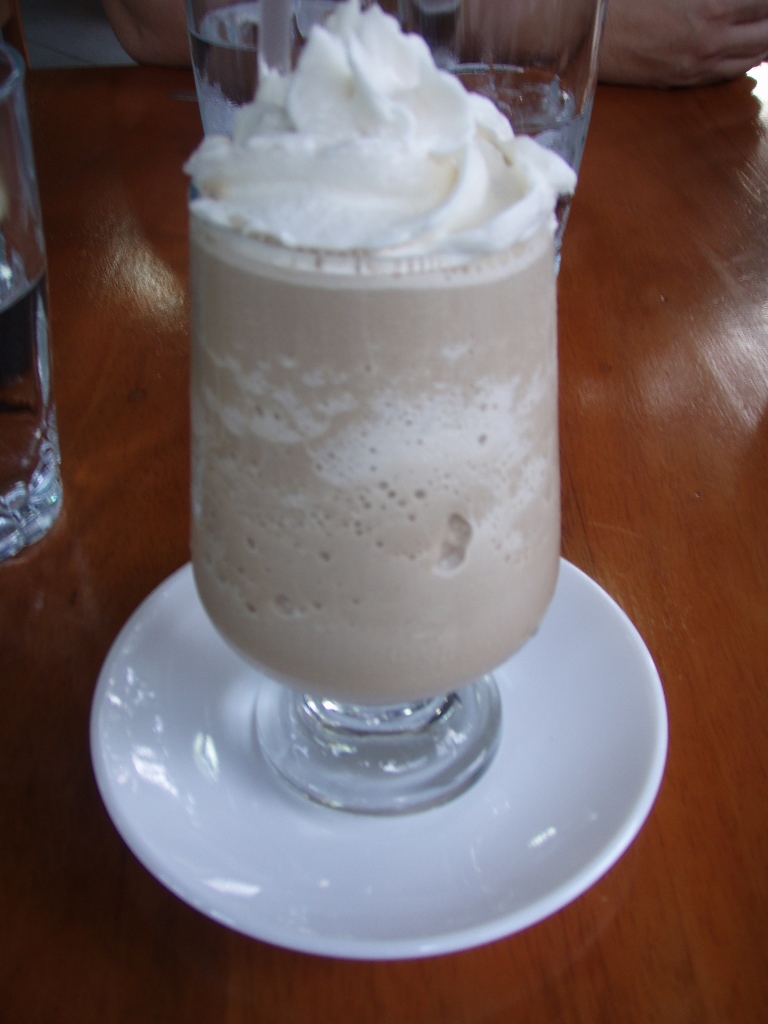 First coffee in Managua
First coffee in Managua
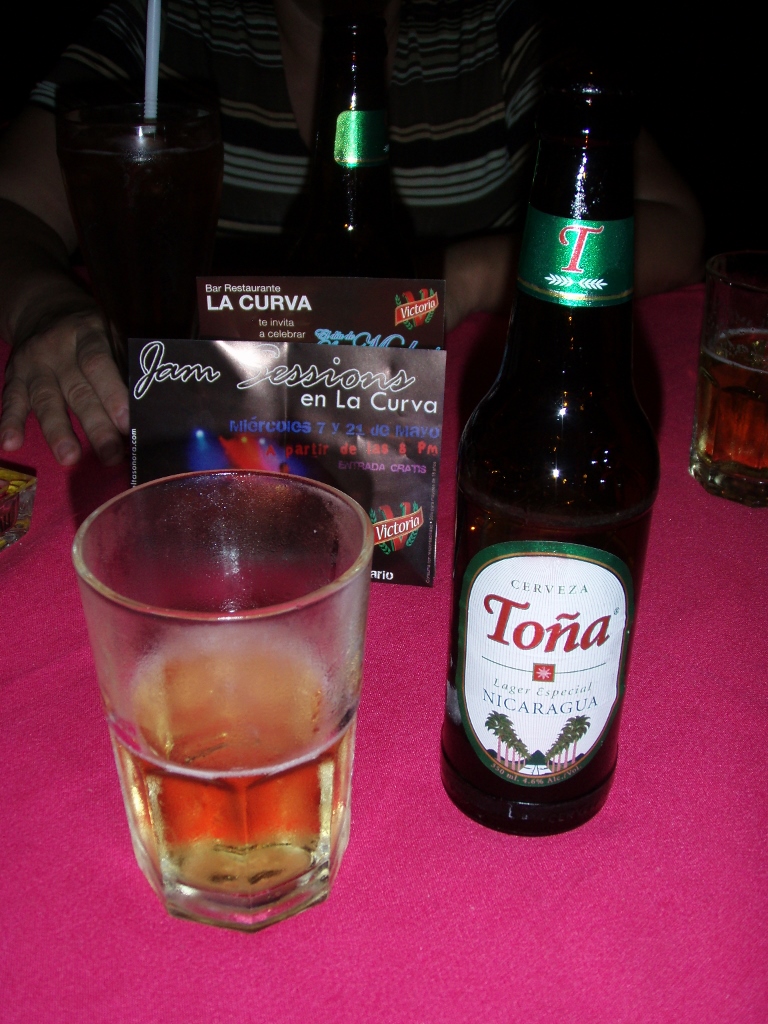 First beer in Managua
First beer in Managua
The way we started I thought we would be stuck in the restaurant, but we actually parted rather early by the two of them accompanying me in a taxi to my guest-house already around 8 in the evening. One of the reasons for this was that we agreed that Patricia should pick me up already at 7 am the next morning in order to go on an excursion to León Viejo. Needless to say, I had no problems going to bed early. Still, while I first sat in the courtyard of the guest-house, corresponding again via internet, the air humidity was exceptionally high and the sensation was quite unpleasant, so I was very glad when I eventually withdrew to my tiny room and turned the air-conditioning on.
When I woke up the next morning and got out into the courtyard, the feeling of temperature and air humidity was quite pleasant, so I felt ready for the day ahead.
The main reason for such early rising was in order to be able to fit everything in, for I was first invited to go to Marta’s for breakfast. It was Sunday and she prepared a famous Nicaraguan specialty – nacatamal.
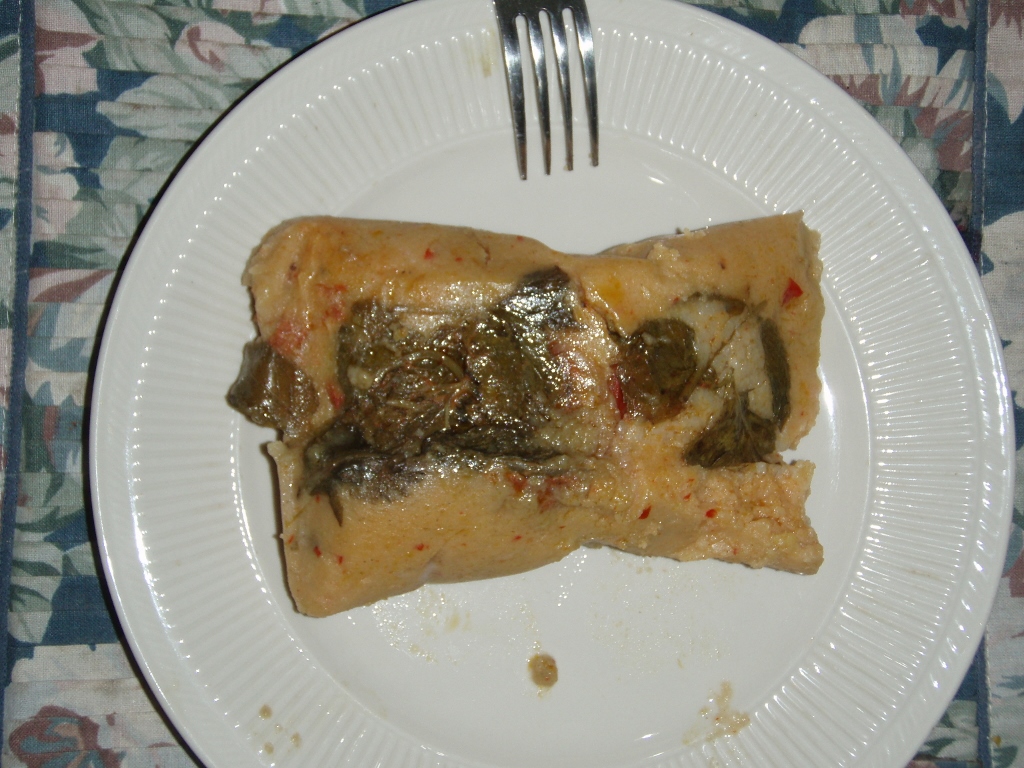 Nacatamal
Nacatamal
This is dish that is quite complex and its preparation requires several hours and more than one pair of busy hands. In any case, the point is that some kind of dough is made of special maize flour, lard and seasonings. Then a certain quantity of the dough, deemed sufficient for a portion, is put on a plantain leaf and the already prepared filling is put over the dough – usually pork and different vegetables. Then the dough and the filling are wrapped into the plantain leaf so that one gets a pillow shape and everything is tied up to prevent its falling apart. The bundles obtained in this way are cooked in steam for several hours. What I want to say that there is no chance I would ever try to make this, but I was certainly glad that I had the chance to try this Nicaraguan version of tamal, a traditional Mesoamerican dish made in a similar way.
Following the breakfast, the three of us went on the daily trip together and to start with we took a taxi to get to a terminal where we boarded one of the passenger vans that serve as inter-city transportation. Meanwhile, it turned out that Patricia thought we would first go to León and then to the archaeological site that I was actually interested in.
León is the second largest city in the country and it used to be the capital of Nicaragua, but it lost this function in 1852 when Managua took over. The point is that nowadays numerous historic buildings can be seen in León, primarily churches, and that certainly makes this city very interesting. Still, I was actually mostly interested in Old León, i.e., León Viejo.
These are the excavations of the first settlement called León which the Spanish conquistadors founded in June 1524. Bearing in mind the seismicity of entire Central America, here too there is a volcano nearby, along with very frequent earthquakes, while the particularly powerful ones were those of 1578 and 1610. Although the 1610 earthquake did not actually destroy the city, but only damaged it significantly, the residents did vote to move the city some 30 km farther to the west and this is the present-day León.
When I think about it now, I should have probably accepted Patricia’s idea to go to León, but for me it was important to go to León Viejo, since at the time this was the only site in Nicaragua that was inscribed in the UNESCO’s World Heritage List and now it’s too late to correct my mistake, since Nicaragua and León are very far away.
Be as it may, after some 60 km or so covered by the van, we got off in a village and took a taxi there since there was no other transportation or the public one went far too rarely. I simply don’t know because here I was in the hands of Patricia and Marta who organised it all and I just following them not meddling into their talks with the local people. Still, this more comfortable taxi ride gave me an opportunity to film something from the car in order to show very briefly some details of the Nicaraguan countryside.
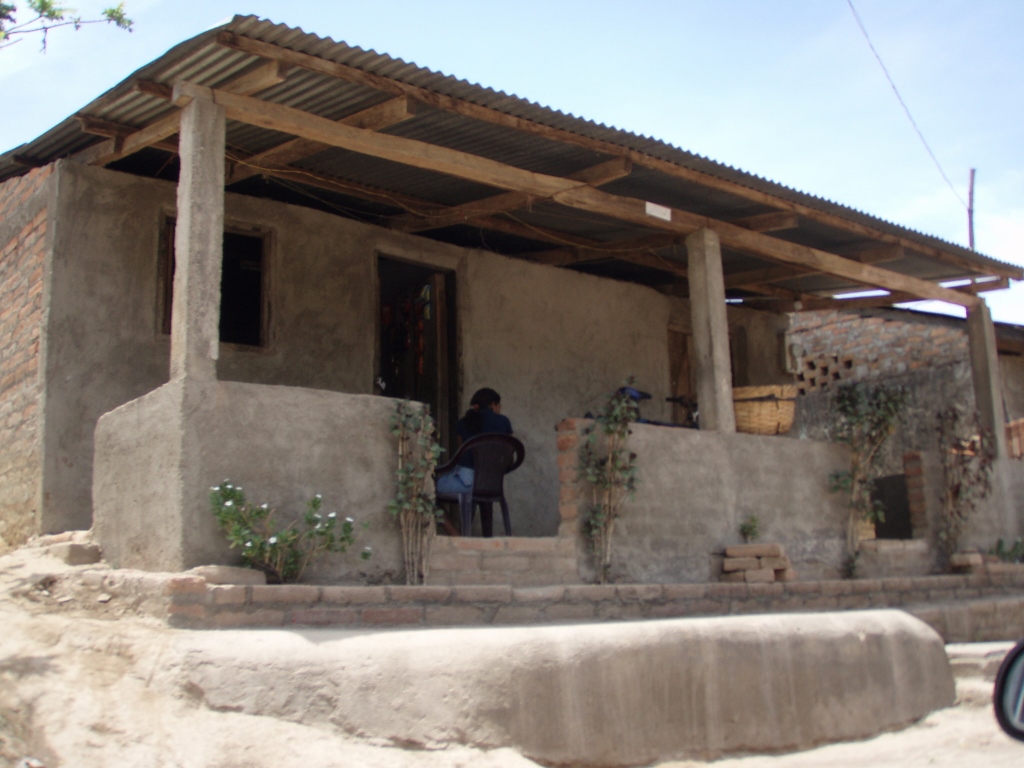 One of the houses in the rural part of Nicaragua
One of the houses in the rural part of Nicaragua